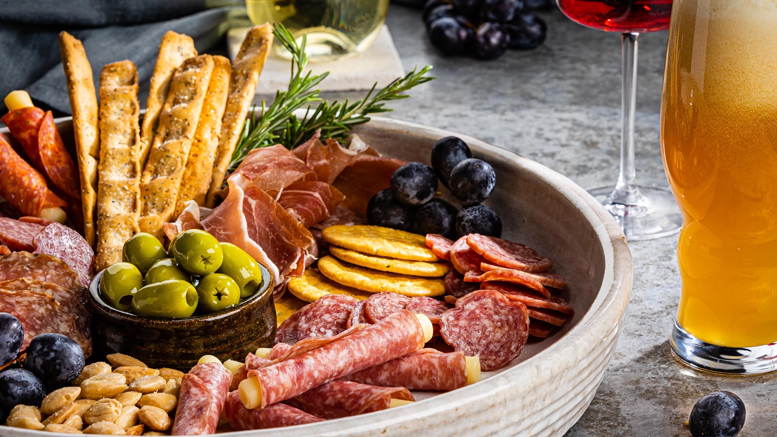Artisan Salami Gravitates From ‘Elevated’ to Everyday
March 19, 2024 | 7 min to read
Artisan salami is gaining traction in the United States, with experts like Shawn Munck of Fiorucci Foods noting a significant increase in offerings and sales. This once-niche category is becoming mainstream, driven by its straightforward preparation and the rising popularity of charcuterie amid a growing interest in international cuisine. The marketplace features a blend of classic salami like prosciutto and pepperoni, alongside more unique varieties such as finocchiona and soppressata, appealing to diverse consumer tastes.

Artisan salami has gained an increasingly strong foothold in the United States marketplace, and providers, retailers and others are eager to see what the future holds.
“As we look at the market data, and what we see in traditional grocers and even online e-commerce, we definitely see that that category is growing,” says Shawn Munck, director of European brands and foodservice for Fiorucci Foods, Chesterfield, VA. “We’ve seen more and more placements of different types of salumi. And when I use that term, that’s everything from prosciutto, salami and pepperoni to other artisanal types of dry-cured meats. So, we’ve seen it growing over time, and we see it reflected in our sales as well.”
Long a category that might have been seen as specialty, artisan salami, in its many varieties, is finding its way into the mainstream. Experts say salami is positioned well for growth, thanks to its simple preparation and accessible flavors combined with the growing profile of charcuterie and a hearty appetite for international cuisine during and after the pandemic.
FLAVORS FAMILIAR AND NICHE
When surveying the artisan salami marketplace, Munck says he sees a mix of familiar staples, such as prosciutto, Genoa salami and pepperoni, with more niche items, such as finocchiona, soppressata and cotta.
“I also see the category growing with the surge in popularity of charcuterie and snacking and grazing because a lot of the products are ready to eat,” says Munck. “There’s no prep involved, a lot of them are pre-sliced or diced, so you can set them out on a plate, and you’re good to go.”

New flavors in the U.S. abound, including many that would not be found in salami’s “home” countries, such as Italy, Spain and Germany, says Claas Abraham, chief executive and president of Abraham of North America.
For instance, Fiorucci recently started to offer a pizza-flavored salami, which has a blend of pizza seasonings, and a charcuterie salami, which Munck calls a mix between a prosciutto and a salami. “That’s for consumers who are not sure what to put on their charcuterie board,” says Munck.
In today’s evolving landscape, Tim Shanley, chief executive of Charcuterie Artisans, says artisan salami “pillars” such as Genoa and soppressata that were once viewed as specialty products are now more often seen as types of traditional salami.
“Consumers expect retailers to curate a selection which places these tentpole items alongside more unique varieties like Spanish chorizo, wild boar or truffle salami,” says Shanley. “And while taste is ultimately king, folks want to know that the product is derived from ingredients sourced ethically.”
Munck says he is seeing more salami in the marketplace that is minimally processed and has fewer ingredients. He believes all-natural products will grow in the category, as will varieties that are lower in sodium, fat or cholesterol.
Abraham says the artisan salami market is relatively saturated with popular items. One item where he sees notable growth is in salami sticks. Abraham believes emphasizing the traditional curing process can remain a path to attracting new consumers. “I think authenticity is the key to growth,” says Abraham.
“As the market evolves, I think that there’s more room for higher-quality items that have the original flavor profiles,” he says.
POPULAR FOR ENTERTAINING AND SNACKING
Charcuterie’s rise in popularity in the U.S. plays an integral role in the growing attention on artisan salami, experts say.
“I don’t think there’s ever been a more exciting time to be in the world of charcuterie,” says Shanley. “What began as a slow and steady gain in popularity has exploded into a full-on renaissance. COVID accelerated this, to be sure, but certain elements — social media, evolving tastes, dietary trends — have aligned perfectly to make it possible.”
Charcuterie Artisans recently completed a study of charcuterie shoppers that includes a mobile ethnography element. Shanley says the study found that consumers are attracted to charcuterie’s versatility and convenience.
The largest usage occasion is entertaining, and slice variety packs are the backbone of entertaining, says Shanley.
Munck says many brands offer variety packs now that have a combination of different types of salami. Some pair them with different cheeses. Those often are found in snacking areas of stores with other grab-and-go items, he says.
Snacking follows entertaining as the occasion in the category that is growing the fastest, says Shanley.
“Powering this growth is an increasing appetite for high-protein, low-carb, on-the-go options that don’t sacrifice flavor,” he says.
Munck says research is demonstrating that snacking has taken an increasingly prominent place in consumers’ daily eating behavior. Snacking typically involves smaller servings than meals and very little preparation time, creating favorable conditions for the versatility of charcuterie in general and salami in particular, says Munck.
“The appeal of it is the customization of charcuterie and how you can kind of make it your own,” he says. “It’s very DIY. There are so many things that you see on social media, different influencers have their content around charcuterie and grazing boards and things like that.”
Abraham believes growing interest in artisan salami in the U.S. also can be traced in part to more Americans traveling to Europe in the aftermath of the pandemic and discovering new products.
“Then they come back home, and they have an interest in finding these products in the local grocery stores,” says Abraham.
Abraham pointed to popular food and cooking shows, such as Stanley Tucci’s program on CNN, as also playing an important role in sparking interest in food such as artisan salami.
The results of that growing interest can be impressive.
“The artistry consumers are putting into their boards is remarkable,” says Shanley. “Conventions of what is — or isn’t — charcuterie have gone out the window. People are exploring flavors, pairings and usage occasions like never before.”
Munck says artisan salami has the benefit of being simple to prepare, so shoppers are not challenged with recipes and cooking methods.
“Most of them are ready to eat and pair well with a lot of different items,” says Munck. “There’s very little prep involved. It’s not like you have to cook them or heat them up, so it’s a very convenient meal or ingredient, especially because so many people are on the go, and they want something fast.”
BUILDING FAMILIARITY
Because artisan salami often is shelf stable, Munck says it offers more flexibility to grocers in how products are displayed. Instead of being limited to refrigerated areas, artisan salami could appear anywhere from the wine section to point-of-sale — in addition to various locations within the deli department.
Abraham says education is critical for consumers who have not already encountered an artisan salami product. Social media offers versatile and engaging platforms to help show consumers how to prepare and present a product.
Munck says consumers typically know what to do with a hard salami or pepperoni, but more specialty items, such as an Italian dry salami, a peppered salami or a soppressata, can confuse consumers uncertain about the best ways to serve them. “Those are the ones we try to educate the consumer about,” says Munck.
Cross-merchandising also is a way of pairing salami products with other items and nudging customers who may be unsure of the best ways to serve salami.
“What kind of goes hand-in-hand with different grocers and retailers is we try to show how you can get incremental, larger basket sizes at checkout by pairing these meats with other, different items in the specialty deli area — or it could be in the produce department and snacking area — to show that there’s just not a one-and-done,” says Munck. “You don’t just purchase the meat, and there’s nothing else that goes with it. There’s a lot of different things that could pair well with it.”
Abraham says mixing a more familiar item with artisan salami can make a passing shopper stop in their tracks and explore the possibilities. In cross-merchandising for artisan salami, Abraham says it is vital to work with other products that will complement the salami, rather than distract from it or overwhelm it. For instance, he says a cracker with a relatively neutral flavor rather than a bolder one would make sense, though you would still want a cracker with a strong bite to support the flavor of the salami while giving it an additional and pleasant texture.
Munck says Fiorucci is among the providers seeking to demonstrate to consumers that artisan salami can be enjoyed in a variety of ways.
“What we’re trying to do, and we’ve done in the past and even more so going into the new year, is showing these types of products not just from a charcuterie or snacking or grazing standpoint, but also how they can be incorporated into different everyday dishes, whether it’s pasta or pizza or salads and soups,” says Munck.
With the right approach, Munck says artisan salami could progress from a special treat to more of a go-to staple.
“We want these products to be an everyday part of people’s lives,” he says.
109 of 140 article in DeliBusiness Spring 2024

